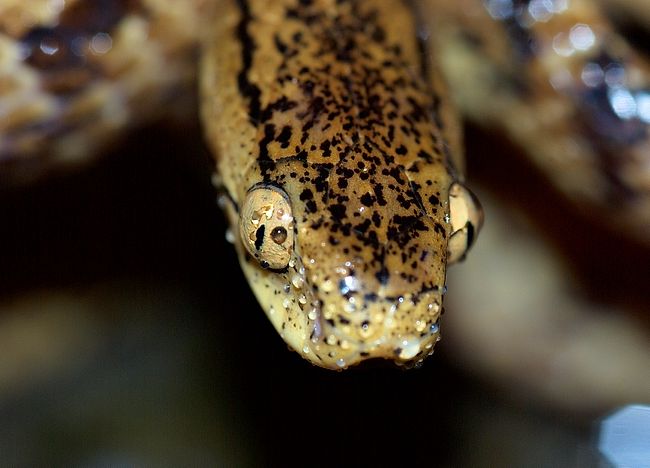Pareas formosensis
Taiwan Slug Snake
台灣鈍頭蛇 (tai2wan1dun4tou2she2)
Status: Protected (Cat.II)
Non-venomous
Family
Colubridae, subfamily Pareatinae
Max. length
70 cm
Occurrence in Taiwan
Throughout Taiwan, mainly up to 2000 m altitude.
Global Distribution
Endemic to Taiwan
Description
Small snake; total length up to 70 cm. There are 15 rows of scales, which are smooth in appearance and glossy; however, 5 to 7 rows near the vertebral line of posterior half of body possess feeble keels. Head, which is distinct from neck, is elongated oval to roughly rectangular with blunt snout; body is slender and slightly compressed laterally; tail is long. Eye is medium-sized; iris is light brown, yellow brown or reddish brown with scattered flecks of diffuse black pigment; pupil is black, oval to elliptical at vertical axis, without definite ring or border. Tongue is long, dark gray to black, with fork tips darker than stem. Upper head is light brown with scattered irregular spots of black. There is a distinct line extending posteriorly from the eye to meet a dark design on the neck and oblique black lines which extend posteriorly behind the parietals; overall designs on head form a ''W''. A second line extends from lower eye to the corner of the mouth. The labials are lighter in color, with scattered spots of black. Upper body and tail are light brown to brown, with flecks of black pigment on each scale; there are irregular crossbars of black usually broken or interrupted at vertebral line. Ventral head is dirty white to cream with scattered spots of black pigment. The chin shields extend irregularly across the middle of throat and there is no median groove. Ventral body is slightly darker than ventral head and mottled with large spots of black, some spots in outer fields of scales tend to form longitudinal lines. Anal scale is entire, and subcaudals are paired.
Biology & Ecology
This nocturnal, semiarboreal snake inhabits humid mountain regions where it feeds mainly on slugs and snails which it hunts during or after rainfalls. This snake is quite cold-tolerant and can be found on the prowl even on cool winter nights if there has been sufficient precipitation.
Just like its prey, this snake moves quite slowly. In summer, the females produce a clutch of 2-9 eggs of 2-3 x 1 cm size; the hatchlings measure about 15 cm in total length. When threatened, some individuals may stretch out the upper jaw bilaterally.
While this snake is of a very docile disposition and is unlikely to bite in defense, it will usually empty the foul-smelling contents of its anal glands when picked up. It also uses its tail to lash out at enemies.
Snakes in the subfamily Pareatinae prey mostly on terrestrial snails and slugs. But their jaws are not strong enough to crush snail shells. When feeding on a snail, the upper jaw fixes on the shell while its long teeth on lower jaw scrape out the snail's body. To move the prey into the swallowing mechanism, snail eating snakes grab the body of the snail, then "walk" in its fleshy body by alternatively moving each side of the lower jaw, whist the upper jaw holds the shell in place. In many slug snakes, this is facilitated by asymmetrically evolved dentures, as a 2007 study shows (see also footnote below):
"The study found that the snail predator Pareas iwasakii had an average of 17.5 teeth on its left jaw and 24.9 teeth on its right jaw (n = 28). A similar asymmetry was demonstrated in the jaws of one unhatched snake, implying that the trait has a genetic basis. Furthermore, the teeth numbers on the jaws were asymmetric in 12 out of 14 pareatine species. One of the remaining 2 species feeds on lizards in addition to snails, while the other one feeds exclusively on slugs." (Source)
Etymology
Pareas = a kind of snake in Ancient Greece;
formosensis = from Taiwan (= Formosa).
The Chinese name 台灣鈍頭蛇 (tai2wan1dun4tou2she2) means "Taiwan (台灣) blunt-headed (鈍頭) snake (蛇)", a reference to its squarish snout.
Notes
A more reddish-colored and red-eyed variety of P. formosensis is currently undergoing research to determine the possibility of it being categorized as a distinct species.
Further Info
Footnotes
Abstract:
External asymmetry found in diverse animals bears critical functions to fulfil ecological requirements. Some snail-eating arthropods exhibit directional asymmetry in their feeding apparatus for foraging efficiency because dextral (clockwise) species are overwhelmingly predominant in snails. Here, we show convergence of directional asymmetry in the dentition of snail-eating vertebrates. We found that snakes in the subfamily Pareatinae, except for non-snail-eating specialists, have more teeth on the right mandible than the left. In feeding experiments, a snail-eating specialist Pareas iwasakii completed extracting a dextral soft body faster with fewer mandible retractions than a sinistral body. The snakes failed in holding and dropped sinistral snails more often owing to behavioural asymmetry when striking. Our results demonstrate that symmetry break in dentition is a key innovation that has opened a unique ecological niche for snake predators.
































